NORTHLAND
The area loosely described as ‘Northland’ in New Zealand is on the east coast of the North Island. It is bordered roughly by Kawakawa in the south and east, Kerikeri in the north, and Cape Brett to the east. This area includes the Bay of Islands which includes Opua – where we spent a month when we first arrived in New Zealand, then we spent another 15 days there waiting for a weather window to leave New Zealand and head north again.
We arrived in Opua, New Zealand, early morning on Tuesday, December 6, 2005. We had had an occasionally bumpy passage, but it was not bad compared to that which many of our friends had experienced. We were excited to finally be in New Zealand.
New Zealand has particularly strict quarantine laws, and Nita had been dreading meeting the quarantine officer. She had heard stories ranging from “no problem” to “they take everything – all rice, flour, etc.”. She had gotten rid of everything she knew was forbidden, but the unknown was still a source of anxiety. As it turned out, customs and quarantine were both relatively painless.
Our heat exchanger developed a crack somewhere in Tonga, and we had been waiting to replace it until arriving in New Zealand. We knew that we would be immobilized in the water for a while, so we opted to go inside the Opua Marina. It had been a long time since we were in a marina, and we have never been in a marina with side-tying slips, power, and water. We were looking forward to this!
Our excitement was somewhat subdued by a series of frustrations. We had a few stumbling blocks related to our heat exchanger, shore power, water, propane tanks, and the price of things in general (very expensive). Then the bugs tried to eat Nita alive. But we survived.
While we were landlocked in the marina, we rented a car for a week and went out and about a bit to see some of the surrounding countryside. We also went to Whangarei – the boating mecca of New Zealand according to many.
Because we were off to a frustrating start, we decided to postpone our boat projects until we are in Auckland. We would spend the remainder of our time in the Northland enjoying the beautiful countryside.
Our first venture out was a walk from Opua to Paihia – probably about 8 miles. The walk is along an oceanfront trail through some very nice areas. There are benches along the trail so that you can stop and sit, and parts of the trail wander through a mangrove forest. It was a very nice walk (except our feet are still not accustomed to shoes).

Along trail from Opua to Paihia
Paihia was a bit too touristy for us. We wanted to do some shopping to finish a few Christmas presents, but there was very little there other than tourist souvenirs (sorry about all the t-shirts this year). We have a bank draft for New Zealand dollars drawn on the Bank of New Zealand, and there is a branch in Paihia, so we went there to cash it. They would not cash their own bank draft! Another frustration… But we found a grocery store with great produce and a good selection of other foods, so all else was forgotten.
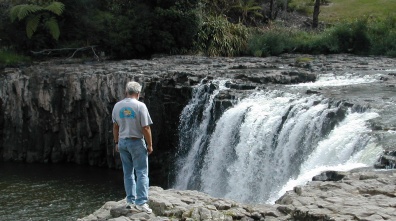
Bud at Hururu Falls
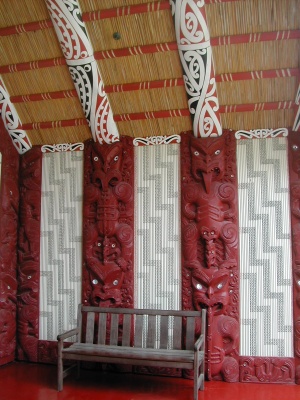
Inside meeting house at Treaty Grounds
We drove up to Kerikeri without any particular expectations, but we were still surprised when we arrived. It seemed just another small town with a complete lack of anything touristy. A refreshing change from Paihia. We found a huge grocery store and spent an hour or two shopping for food. By the time we got out of the grocery store, the local winery had closed – no tasting that day. And by the time we got back it was dark – after 9:00 pm around here.
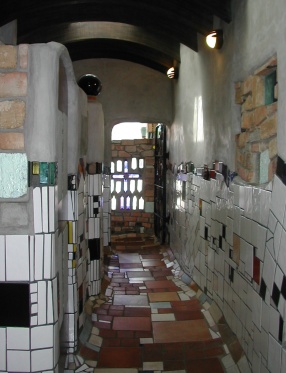
Women’s bathroom in Kawakawa
On our way back from one of trips to Whangarei, we stopped in Kawakawa to look at the public toilets. Yep. We stopped to visit the Hundertwasser toilets. Friedensreich Hundertwasser was an Austrian-born artist and eco-architect. He lived his final 27 years in a remote house in Kawakawa, and he designed the public toilets there. Consistent with his other work, they include lots of wavy lines, and they are decorated with ceramic mosaics and colored bottles. And there are plants growing on the roof. Needless to say, these toilets are often photographed; however, Nita still felt a bit odd each time her flash fired in the women’s room. They were unique.
And our other big outing was to Russel. There is a tall ship replica, the R. Tucker Thompson, that ties up in Opua at night. Each morning she goes to Russel first thing to pick up passengers for a day sail. Then, at the end of the day, she drops the passengers at Russel and goes back to Opua for the night. They offer free rides from Opua to Russel and back to the cruisers staying in Opua Marina. We thought it would be an adventure in itself to sail on the Thompson, so we headed off for a day in Russel.
We were surprised to learn that the Thompson is only about 20 years old. She looks like an old tall ship, and she is in rougher condition than we would expect for her age, but the charter business is rough on all vessels. Although we did not raise any sails in the short trip across to Russel, the ride offered a taste of what sailing on her might be like. But we disembarked in Russel for a day of exploring.
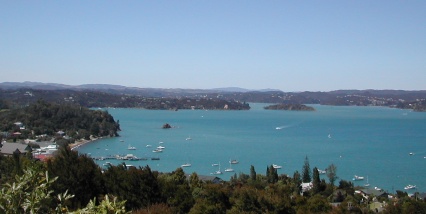
Hilltop view of Russel
Russel has an interesting history. Russel was called Kororareka, which means “sweet penguin” in Maori, until 1844. During the days of sealing and whaling in New Zealand, Kororareka was considered the most lawless town in the Pacific. The sealers and whalers came to town during their down time, and they had a raucous good time. The town’s population reportedly had a disproportionate number of barkeeps and prostitutes. However, despite its rough reputation, Kororareka was the site of both the first church (1836) and the first capital of New Zealand (eventually the capital moved to Auckland then to Wellington). And today, there is an obvious effort to retain the historical sites and buildings around town.
We hiked for a few hours and somewhat followed a route called the “heritage trail” that passes by 20 identified points of interest. We also wandered off and went to visit a few other identified historical sites.
Our favorite site in town was the police station. It is a Victorian Gothic building that was built in 1870 as a customs house. We had never seen such an ornate building serve as a police station.
Our favorite site out of town was the flagstaff at Maiki Hill. We have both read a bit on the history of New Zealand, and we were aware of the significance of this particular flagstaff. We also enjoyed the spectacular views from atop Maiki Hill.
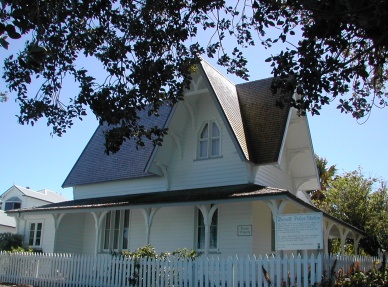
Russel Police Station
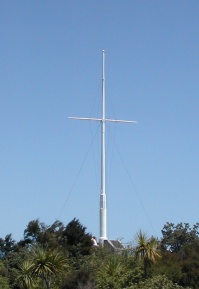
Flagstaff on Maiki Hill
We enjoyed a stop at the Visitors’ Center (these are particularly well done in New Zealand), and we bought a few ‘must-have’ souvenirs. The day was almost done, and we needed to get back to the dock to catch our ride back to Opua on the Thompson.
We saw her sail by, and we figured that she would turn around and come back to Russel (she had a boatload of passengers that she had picked up there). So we sat and waited. And waited. After an hour or so, we asked at the booking desk if we had missed them. No, they had not yet returned. After another hour or so, we asked again. The booking desk called across the harbor and was told that it was too windy for the Thompson to return to Russel, so she went directly to Opua. We were stranded. We took a cab out to the auto ferry which is just across from Opua, and we rode the ferry the short distance back. In the middle of the channel we saw our first blue penguin (the korora), so we decided that, all in all, it was good that we were where we were. It was a very cool day despite the minor glitch at the end.
During our first stay in Opua, we also made a brief visit to Whangarei and a trip to the kauri forests. Then we spent 16 days sailing from Northland to Auckland and more than three months in Auckland. We left Auckland on April 30 to return to Opua for our second visit before heading north for another season in the tropics.
We left Auckland on April 30. We had too little wind to sail, so we motorsailed for much of the day. However, late in the afternoon we had enough wind to enjoy a beam reach with a full main and #2 jib. It felt really, really good to be sailing again! We sailed only as far as Lady Alice Island which is one of the group that locals call the Hen and Chickens Islands (Lady Alice is one of the chickens). We arrived just before dark, and we stayed on board. The darkness that night was remarkable. We were less than a full day out of Auckland, and it felt as though we were the only two people on the planet.
We left early in the morning so that we could get to Opua before dark. We had the wind on our nose in the morning, and we were somewhat pressed for time, so we motorsailed again. We again enjoyed the beauty of the coastline, and after an uneventful day, we arrived Opua at 5:00 pm – in time to get secured before dark. We were one step closer to being out cruising again.
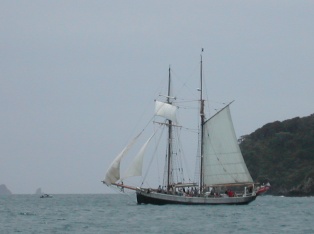
R. Tucker Thompson
When we returned to Opua, it was crowded with other cruisers. There were a few that we had seen, but most we had not seen all summer. They, too, were waiting for a weather window to head back to the tropics.
We enjoyed catching up with the summer adventures of our friends, and we were particularly pleased when Michael of SV Yonita stopped by our boat to say hello. Although we had been in occasional e-mail contact, we had not seen Michael since his health crisis in Niuatoputapu, Tonga at the beginning of October last year. And we didn’t know he had arrived Opua on his way back up to Tonga. His health problem is under control, and he is back out there cruising again. Michael, on his second circumnavigation, has a spirit that is inspiring.
We were very pleased with the weather routing we received from Bob McDavitt of New Zealand’s Metservice last fall when we sailed from Tonga south to New Zealand, so we decided to use his service again. His advice was for us to leave Opua mid-day on May 16 which was one day after Bud’s visa expired. However, we talked with immigration, and they had no problem extending his visa a few days to accommodate our weather concerns. So we worked furiously to be ready on the 16th.
We needed to get away from the cold weather and the incessant sandflies that were again eating Nita. And we needed to get back to our cruising lifestyle that changes so drastically when in a marina. We were ready, and we were off mid-day on May 16.
Return to our New Zealand page, follow our sail from New Zealand to Fiji or jump ahead to our Fiji page.